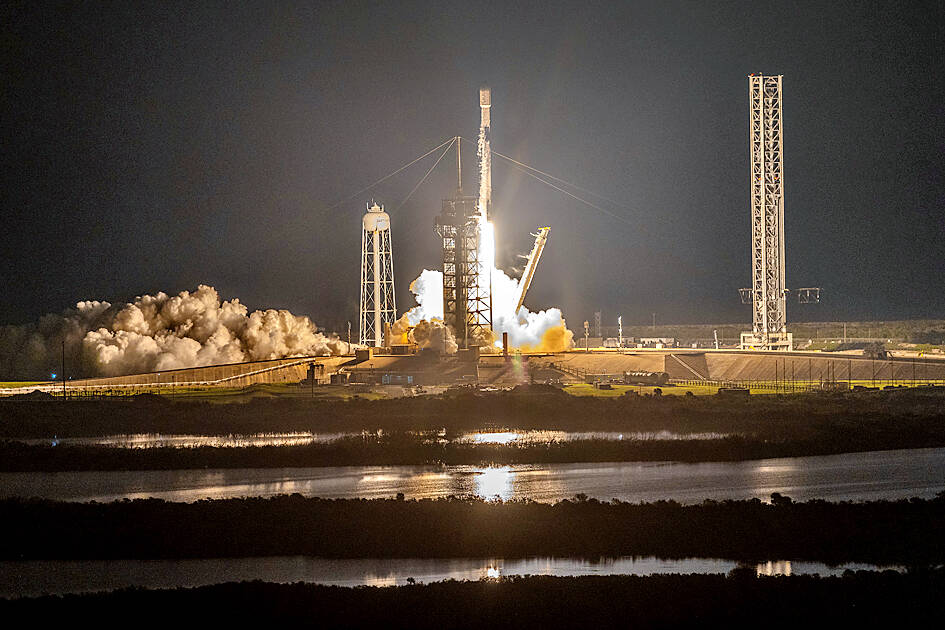A private company launched another lunar lander on Wednesday, aiming to get closer to the moon’s south pole this time with a drone that would hop into a jet-black crater that never sees the sun.
Intuitive Machines’ lander, named Athena, caught a lift with SpaceX from NASA’s Kennedy Space Center. It is taking a fast track to the moon — with a landing on Thursday next week — while hoping to avoid the fate of its predecessor, which tipped over at touchdown.
Never before have so many spacecraft angled for the moon’s surface all at once. Last month, US and Japanese companies shared a rocket and separately launched landers toward Earth’s sidekick.

Photo: EPA-EFE
Texas-based Firefly Aerospace should get there first this weekend after a big head start.
The two US landers are carrying tens of millions of dollars of experiments for NASA as it prepares to return astronauts to the moon.
“It’s an amazing time. There’s so much energy,” NASA’s science mission chief Nicky Fox said a few hours ahead of the launch.
This is not Intuitive Machines’ first lunar rodeo. Last year, the Texas company made the first US touchdown on the moon in more than 50 years, but an instrument that gauges distance did not work and the lander came down too hard and broke a leg, tipping onto its side.
Intuitive Machines said it has fixed the issue and dozens of others. A sideways landing like last time would prevent the drone and a pair of rovers from moving out. NASA’s drill also needs an upright landing to pierce beneath the lunar surface to gather soil samples for analysis.
“Certainly, we will be better this time than we were last time, but you never know what could happen,” senior vice president of space systems Trent Martin said.
It is an extraordinarily elite club. Only five countries have pulled off a lunar landing over the decades: Russia, the US, China, India and Japan. The moon is littered with wreckage from many past failures.
The 4.7m Athena would target a landing 160km from the lunar south pole. Just 400m away is a permanently shadowed crater — the ultimate destination for the drone named Grace.
Named after the late computer programming pioneer Grace Hopper, the 1m drone would make three increasingly higher and longer test hops across the lunar surface using hydrazine fueled-thrusters for flight, and cameras and lasers for navigation.
If those excursions go well, it would hop into the nearby pitch-black crater, an estimated 20m deep.
Science instruments from Hungary and Germany would take measurements at the bottom while hunting for frozen water.
It would be the first up-close peek inside one of the many shadowed craters dotting both the north and south poles. Scientists suspect these craters are packed with ice. If so, this ice could be transformed by future explorers into water to drink, air to breathe and even rocket fuel.
NASA is paying US$62 million to Intuitive Machines to get its drill and other experiments to the moon. The company, in turn, sold space on the lander to others. It also opened up the Falcon rocket to ride-sharing.
They included NASA’s Lunar Trailblazer satellite, which would fly separately to the moon over the next several months before entering lunar orbit to map the distribution of water below.

Two Belgian teenagers on Tuesday were charged with wildlife piracy after they were found with thousands of ants packed in test tubes in what Kenyan authorities said was part of a trend in trafficking smaller and lesser-known species. Lornoy David and Seppe Lodewijckx, two 19-year-olds who were arrested on April 5 with 5,000 ants at a guest house, appeared distraught during their appearance before a magistrate in Nairobi and were comforted in the courtroom by relatives. They told the magistrate that they were collecting the ants for fun and did not know that it was illegal. In a separate criminal case, Kenyan Dennis

Incumbent Ecuadoran President Daniel Noboa on Sunday claimed a runaway victory in the nation’s presidential election, after voters endorsed the young leader’s “iron fist” approach to rampant cartel violence. With more than 90 percent of the votes counted, the National Election Council said Noboa had an unassailable 12-point lead over his leftist rival Luisa Gonzalez. Official results showed Noboa with 56 percent of the vote, against Gonzalez’s 44 percent — a far bigger winning margin than expected after a virtual tie in the first round. Speaking to jubilant supporters in his hometown of Olon, the 37-year-old president claimed a “historic victory.” “A huge hug

A judge in Bangladesh issued an arrest warrant for the British member of parliament and former British economic secretary to the treasury Tulip Siddiq, who is a niece of former Bangladeshi prime minister Sheikh Hasina, who was ousted in August last year in a mass uprising that ended her 15-year rule. The Bangladeshi Anti-Corruption Commission has been investigating allegations against Siddiq that she and her family members, including Hasina, illegally received land in a state-owned township project near Dhaka, the capital. Senior Special Judge of Dhaka Metropolitan Zakir Hossain passed the order on Sunday, after considering charges in three separate cases filed

APPORTIONING BLAME: The US president said that there were ‘millions of people dead because of three people’ — Vladimir Putin, Joe Biden and Volodymyr Zelenskiy US President Donald Trump on Monday resumed his attempts to blame Ukrainian President Volodymyr Zelenskiy for Russia’s invasion, falsely accusing him of responsibility for “millions” of deaths. Trump — who had a blazing public row in the Oval Office with Zelenskiy six weeks ago — said the Ukranian shared the blame with Russian President Vladimir Putin, who ordered the February 2022 invasion, and then-US president Joe Biden. Trump told reporters that there were “millions of people dead because of three people.” “Let’s say Putin No. 1, but let’s say Biden, who had no idea what the hell he was doing, No. 2, and